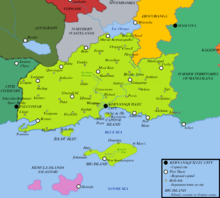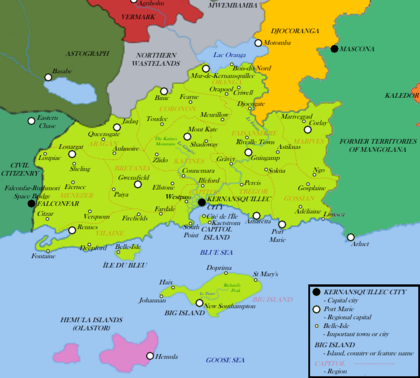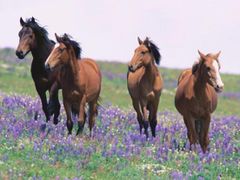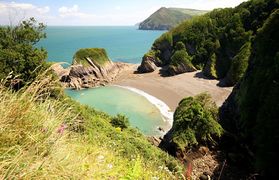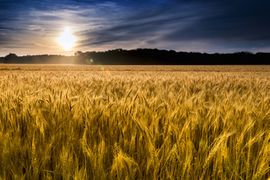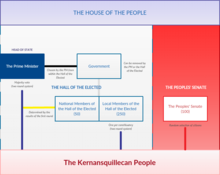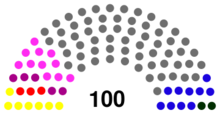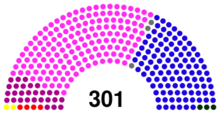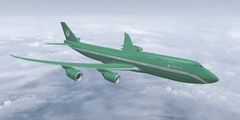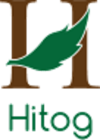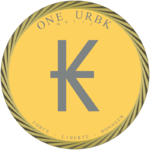Kernansquillec
| This page is a work in progress by its author(s) and should not be considered final. |
| The Parliamentary Republic of Kernansquillec
|
|||||
|---|---|---|---|---|---|
|
|||||
| Motto: "Force, Liberté et Honneur." "Strength, Freedom and Honor." |
|||||
| Anthem: "Hills of the Motherland" | |||||
Kernansquillec in the Gold Coast (Rushmore)
|
|||||
| Region | Rushmore | ||||
| Capital and largest city | Kernansquillec City | ||||
| Official languages | English, French | ||||
| Ethnic groups | 91.9% Kernansquillecan 2.8% Uzekian 1.4% Mangolanian 3.9% Other |
||||
| Demonym | Kernansquillecan | ||||
| Government | Parliamentary Republic | ||||
| - | Prime Minister | Daina Leonardsson (Dem) | |||
| - | The Peoples' President | Brandee Danniell (Vox) | |||
| Legislature | The House of the People | ||||
| - | Upper house | The Hall of Elected | |||
| - | Lower house | The Peoples' Senate | |||
| History | |||||
| - | Kernakàn unified | 23rd November 881 | |||
| - | Reunification | 6th February 1378 | |||
| - | The First Republic | 10th October 1743 | |||
| - | The Second Republic | 15th June 1765 | |||
| - | Currant Republic | 1st July 2032 | |||
| Area | |||||
| - | Total | 1,976,986 km2 763,318 sq mi |
|||
| - | Water (%) | 2.3% | |||
| Population | |||||
| - | 2065 estimate | 301,296,931 | |||
| - | Density | 152.40/km2 394.7/sq mi |
|||
| GDP (nominal) | 2068 estimate | ||||
| - | Total | N$D 16.648 trillion (₭ 10.400 trillion) |
|||
| - | Per capita | N$D 55,257.50 (₭ 34,510.68) |
|||
| Gini (2068) | 0.070 low |
||||
| HDI (2070) | 0.848 very high |
||||
| Currency | The Urbk (₭) | ||||
| Time zone | Branta Time (UTC+1) | ||||
| The nation does not observe DST. | |||||
| Date format | dd/mm/yyyy | ||||
| Drives on the | left | ||||
| Calling code | +22 | ||||
| ISO 3166 code | KRN | ||||
| Internet TLD | .krn | ||||
Kernansquillec ([kɜ:ʳnoʊnski:jek]), officially the Parliamentary Republic of Kernansquillec (French: République Parlementaire de Kernansquillec [ʁepyblik paʁləmɑ̃tɛʁ də kɜ:ʳnoʊnski:jek]), is a sovereign state comprising territory in south western Rushmore. Kernansquillecan territory extends from Lac Oranga and Uzekia to the Goose Sea, from Civil Citizenry to the former territories of Mangolana. Kernansquillec spans 1,976,986 km² (763,318 sq mi) and has a total population of 301.3 million. It is a unitary semi-parliamentary republic with the capital in Kernansquillec City, the country's largest city and commercial hub.
The first humans to live in the modern-day region of Kernansquillec are believed to have arrived around 2500BT. Settlements began to develop from the end of the Prehistoric Era and by the 6th century most of Kernansquillec was divided into a large system of city-states. An actual unified country covering the territory of modern-day Kernansquillec would only emerge with the Kernak Era. Following the conquests of Kernak I and his son, Kernak II, a nation - by the name of Kernakàn - was founded on the 23rd November 853.
The unified nation would not last however. By the turn of the millennium a Dark Age had set upon the land as Kernakàn was split in two: northern Oranges and southern Kernanski. The division between the two halves would remain in place until 1378 when an actual nation called Kernansquillec was born. The price for unity was high however, as the nation became subdued by a radical theological regime known as the Saviors. The regime would last until the mid-18th century when a new struggle was born: the fight for democracy. Two civil wars would follow one another, but the 1st October 1765, the constitution of the Second Parliamentary Republic of Kernansquillec was signed by Kernansquillec's new Prime Minister, Benjamin Orinda.
Kernansquillec was developed at a fast pace afterwards and soon became an economic powerhouse in Rushmore. Everything changed in 2020 however as the Great War began. A seemingly stable and prosperous nation was dragged into an eleven year long war that would drain resources and bring the country to the brink of collapse in the fight against Uzekian forces. Victory in July 2031 marked the beginning of the Third Republic and set in motion the construction of today's Kernansquillec.
Since the rise of the First Republic, Kernansquillec's cultural and economic influence in Rushmore has grown. Kernansquillec is one of the most popular destinations for foreign visitors in Rushmore with an estimated 145 million tourists arriving every year. Kernansquillec is a developed economy, producing an estimated 16.648 trillion N$D worth of GDP per year, while managing to keep a very high level of living for all citizens. Kernansquillec is famed for its incredibly low Gini coefficient with the divide between rich and poor greatly reduced thanks to ambitious taxation policies. Kernansquillec also performs well in terms of welfare spending, public education and eco-friendliness.
Kernansquillec is a well respected power in the world. It is a member of the World Assembly and of the Security Council. Kernansquillec also has a developped military force of over 233,000 personnel.
Contents
Etymology
Kernansquillec's name is derived from the name of the first country to be formed on it's mainland, Kernakàn, which in turn was named after it's first King, King Kernak I. Kernakàn then evolved into Kernanski during the Dark Ages before a nation called Kernansquillec was born in 1378. The first mention of the name being used can be dated back to 1303.
Kernansquillec's inhabitants are known as Kernansquillecans while the country's name can be shortened to the trigramme KRN, namely for international sporting events such as the Olympic Games or the UICA's Champions' Cup.
History
Main Article: History of Kernansquillec
After the most recent conflict in Kernansquillecan history, many historical records were destroyed. But after much research, many records have now been restored and historical research is a booming field of study in Kernansquillecan universities.
Prehistory
Main Article: Prehistoric Era in Kernansquillec
The Prehistory Period is defined as the period that precedes the start of the construction of a true Kernansquillecan state and is generally considered to have ended once a written trace of time keeping was discovered in the year zero. The first traces of man settling in Kernansquillec date back to around 2500BT with the oldest traces, wall paintings in a cave, being found close to Lac Oranga in Northern Kernansquillec. As the number of human communities sprung up, eventually a "southern push" took place, with many communities moving to the southern and western parts of the land. By 1600BT experts believe that most of Kernansquillec's south coast had human settlements that had started to farm and build huts.Progress was being made fast by these first Kernansquillecans. Estimate put the population of Kernansquillec around 750BT at about 80 000 individuals. The end of the prehistoric period is marked by the development of written and spoken language. The Kernansquillecan language evolved from primitive grunts to audible words and even phrases by 750BT and by 200BT a rich vocabulary had evolved and the first written words even started to emerge. Some evidence shows that a form of schooling had even evolved in certain tribes to the west of Kernansquillec by 150BT.
The Building of a Nation
Main Article: The rise of Kernakàn
Beginning with a period known as L'Avènement - which sees the birth of social-political structures that have a true form of governance as well as the implantation of the idea of uniting all of "the Green lands", an area roughly corresponding to modern-day Kernansquillec and Uzekia - many leaders would attempt to unify the whole of these "Green lands". Mont Kate's ruler, King Julios III, would come the closest to this goal by the mid 700s. His claim would not last and his Empire returned to being just a big part of the region, rather than a solidary shareholder.The battle to unify Kernansquillec would last 39 years before succeeding. Launched by King Kernak I who had led the reconquering of his homelands annexed by the Southern Empire in 777, his army continued to lead multiple campaigns throughout Kernansquillec before his son, King Kernak II, finally succeded in unifying all of the "Green Lands". He would go on to proclaimed the birth of the first Kernansquillecan state Kernakàn on the 23rd November 853.
A Kernak dynasty would follow, but was plagued by economic difficulties, poorly planned military campaigns and the constant struggle for power between the head of state and local lords. A revolt in 880 even led to the execution of the King Kernak III following a rebellion led by local lords. Lord Julios, one of the king's brother would succeed him, but a rebellion against his "illegitimate" rule by his older brother, Kernanik, would follow, leading to a two year war that ended with Julios fleeing Kernakàn. Kernanik was crowned king and would rule for 35 years, creating a much more stable regime based upon compromise with local lords. Later, the Royal family would begin to slowly accumulate more and more powers, but it never managed to make itself untouchable. And following a poorly planned war in the East and increasing pressure on agricultural and financial resources, a northern rebellion by the "Oranges", led to the end of a united Kernansquillec, as Southern "Kernanski" led a rebellion in the capital that saw King Francis I being executed on the 14th February 1030, officially bringing to an end the House of Kernak and with it, Kernakàn.
The Dark Ages
Main Article: The Dark Ages in Kernansquillec
The Struggle for Democracy
Main Article: The Birth of the First and Second Republics
Reconstruction and Democracy
Main Article: Life under the Second Republic
A Modern Tragedy
Main Article: The Great War
Contemporary period
Main Article: Present-day Kernansquillec
Geography
Location and borders
Kernansquillec is located in the Goose Coast region of South-West Rushmore. It is bordered by Civil Citizenry and Astograph in the West, Uzekia and Djocoranga in the North and by the former territories of Mangolana in the East. In the south Kernansquillec is bordered by the Blue Sea and the Goose Sea and also has maritime border with the Hemula Islands of Olastor.
Kernansquillec has a land mass of 1,976,986 km² (763,318 sq mi) comprised for the most part in the mainland, while the islands of Big Island, Île du Bleu and Capitol Island make up the rest. With its island possessions Kernansquillec possesses territorial waters covering 4,629,231 km² (1,787,356 sq mi) and has an exclusive economic zone covering 28,254,329 km² (10,909,057 sq mi).
Located within central Kernansquillec and at 4,126.52 meters (13,538 feet) above sea level, Mont Kate is the tallest point in the country. Kernansquillec also has extensive river systems, most notably the Faisan, the Gingère and the Tissier.
Regions
Kernansquillec is divided into thirteen administrative regions. Each region has a regional capital, which is home to the region's assembly (Assemblée Régionale), composed of 41 directly elected members. Regional assemblies are changed with funding primary and secondary schools, coordinating local transport networks (bus, train), investing in the local economy and advising national government on what the needs of the region are.
One particularity of the 13 region system is the status of Île-du-Bleu which enjoys a semi-independent status for the region of Vilaine, electing its own Assembly (which sends delegates to the Vilaine Assembly) and shares competences with the Vilaine Assembly in certain areas (primary school, fishing and shipping rights).
The Capitol region is the largest in terms of population with over 51 million inhabitants.
The thirteen regions and their capitals are as follows:
| Region | Regional Capital | Population | Postcode |
|---|---|---|---|
| Aragàn | Jadaq | 13,954,387 | K11 XXX |
| Big Island | New Southampton | 35,844,617 | B01 XXX |
| Bretania | Gwensfield | 16,027,944 | K06 XXX |
| Capitol | Kernansquillec City | 51,301,190 | K01 XXX |
| Coronon | Binic | 17,306,913 | K09 XXX |
| Faisanshire | Guingamp | 31,287,179 | K03 XXX |
| Gossian | Port Marie | 22,021,567 | K07 XXX |
| Katines | Mont Kate | 14,575,383 | K02 XXX |
| Marives | Corlay | 14,560,375 | K08 XXX |
| Menezer | Louargat | 21,459,356 | K05 XXX |
| Oranga | Mur-de-Kernansquillec | 21,491,532 | K10 XXX |
| Trégor | Amaretta | 15,594,614 | K12 XXX |
| Vilaine
(including) |
Rennes
Île-du-Bleu |
25,871,874
6,986,004 |
K04 XXX
I01 XXX |
Climate
Kernansquillec has a fairly temperate climate though it does chance throughout the country. Along the South Coast the climate is much warmer, with the temperatures usually well into the mid to high twenties during the summer. Central Kernansquillec is much cooler in general, especially around the mountain range that runs from south-west of the city of Mont Kate up to the south of Mur-de-Kernansquillec. There is also a much smaller mountain range in central Big Island that often causes heavy downfalls during Spring.
Across Kernansquillec average temperatures range from -6°C to 5°C during the winter months up to 17°C to 26°C during peak summertime. Rainfall follows a similar pattern with around 100mm during the winter months, while the summer sees about half as much.
Environment and Wildlife
Kernansquillec is generally considered to be one of the most environmentally friendly countries in Rushmore with the country having turned carbon-neutral since 2046. With it clean, fresh air, beautiful landscapes and clean natural water, it has significantly develop a large tourism sector despite the weather hardly being one of a paradise. Strict business regulations, public policies and law enforcement has allowed for a balance to be found between economic production and environmental protection.
Thanks to these efforts, wildlife has thrived. Amateur and recreational hunting has been banned since 1822, while the first national parks were created in 1492. Kernansquillec is an animal loving nation with over half of households owning a pet. Animals and wildlife are well looked after, with violence against animals dealt with in a harsh manner. Animals have had their own separate judicial status since 1910 allowing crimes to be punished in manner that often are barely different from similar crimes against humans.
Demographics
Population
The latest census dates back to 2065 and estimates the population of Kernansquillec to be 301,296,931 with an average density of 152.40 inhabitants per square km. As of 2065, around 25% of the population were under 18 years old, 54.9% were aged between 18 and 65 years of age, while over 65s accounted for 20.1% of the populationn. Life expectancy is very high and is estimated to be 85.82 years. An overwhelming majority of the population are of Kernansquillecan nationality (91.9%). The remaining population is composed mostly of Rushmori citizens, namely for neighboring states, especially from Mangolana following the implosion of the state to the East of Kernansquillec. Uzekians (2.8%) form the largest minority. The currant gender ratio is very balanced with 1002 girls per 1000 boys.
Language
Kernansquillec has to particularity of having two national languages: English and French. Both are used regularly with an estimated 97% of the population being bilingual. While English is the more commonly used, both are taught in schools equally. French is often the dominating language in northern regions, namely in Oranga. Regional dialects do still exist in some regions, such as Breton, Uzekian and Lithuanian. However, they do not have any official status and their speaking populations have tended to decline over the past decades.
Largest Cities
Kernansquillec's population is largely a city dwelling population with just 16% of the population living in the countryside. The twenty largest cities in Kernansquillec have a population of over 189 million. Kernansquillec City, the capital, has the largest population of any Kernansquillecan city at just over 26 million.
| Largest cities or towns of Kernansquillec 2065 census | |||||||||
|---|---|---|---|---|---|---|---|---|---|
| Rank | Name | Region | Pop. | Rank | Name | Region | Pop. | ||
 Kernansquillec City New Southampton |
1 | Kernansquillec City | The Capitol | 26,268,216 | 11 | Mur-de-Kernansquillec | Oranga | 6,519,226 |  Guingamp  Port Marie |
| 2 | New Southampton | Big Island | 20,129,364 | 12 | Gwensfield | Bretania | 6,485,264 | ||
| 3 | Guingamp | Faisanshire | 14,729,692 | 13 | Cité de l'Île | The Capitol | 6,407,362 | ||
| 4 | Port Marie | Gossian | 12,019,020 | 14 | Jadaq | Aragàn | 6,384,545 | ||
| 5 | Rennes | Vilaine | 11,969,256 | 15 | Illeford | The Capitol | 6,284,356 | ||
| 6 | Binic | Coronon | 10,521,002 | 16 | St Mary's | Big Island | 6,185,232 | ||
| 7 | Amaretta | Trégor | 9,215,649 | 17 | Belle-Isle | Vilaine | 6,081,262 | ||
| 8 | Louargat | Menezer | 8,752,649 | 18 | Criwell | Oranga | 6,075,361 | ||
| 9 | Corlay | Marives | 7,665,264 | 19 | Citzar | Menezer | 5,864,555 | ||
| 10 | Mont Kate | Katines | 7,005,958 | 20 | Riveille Town | Faisanshire | 5,200,002 | ||
Politics
Government
The Parliamentary Republic of Kernansquillec is a unitary semi-parliamentary republic with strong democratic traditions. The Constitution of the Third Republic was approved by referendum on the 1st July 2032. The executive branch has one leader, the Prime Minister, who is the head of state and elected for a five-year renewable term by direct adult universal suffrage. The Prime Minister is also the head of the government and has to power to name and remove ministers.
The Kernansquillecan legislature, the House of the People, is a bicameral system comprising the Hall of the Elected and the Peoples' Senate. The Hall of the Elected (also simply known as the Hall) is composed of 250 members who represent constituencies and are directly elected for renewable five-year terms, as well as an additional 50 members who's seats are distributed to lists based on their performances in the first round of the Prime Ministerial election. The Prime Minister holds the 301st seat of the Hall. The Hall has the power to dismiss the government (though not the Prime Minister himself) meaning that the Prime Minister can only form a government from the majority group of the Hall. In practice it is rare for such a situation to occur and has so far led to the Prime Minister resigning of his own accord and new general and Prime Ministerial elections being held.
Members of the Peoples' Senate (senators) are chosen at random for one-year non renewable terms from the register of citizens, a register containing all citizens of Kernansquillec registered to vote. The drawing of senators takes place every 1st July and is conducted in public by the Prime Minister. Certain dispensations can be made for those drawn, such as military and educational obligations, health problems and parenthood. Members of the Senate are compensated with an income worth ₭160,000, the same salary as the Prime Minister and other Members of the Hall of the Elected. While the Senate's powers are limited, they are able to introduce legislation and can force legislations to be submitted as a referendum with a double rejection of a bill.
Kernansquillecan politics are very open and have multiple parties with considerable influence. In the Hall, the Democratic Party and the Union of Representatives are generally the strongest forces, while in the Peoples' Senate Vox is nearly always the strongest force by a considerable margin. The latest elections were held in 2068 and the Democratic Party retained their majority.
Referendums are a common part of political life in Kernansquillec and bi-annual referendum days are now a firm part of the calendar. Referendums can be held either by a Prime Ministerial Act, a 2/3rds majority vote in Parliament, or a majority vote in Parliament after the Senate twice rejected the same bill (once the Senate has rejected the same bill twice in a row, Parliament may no longer discuss legislation on the subject and must hold a vote on wherever to abandon the legislation or submit it for a referendum).
Kernansquillecan citizens of the age of 17 and over are eligible to vote and stand for election, baring certain exceptions (mental illness, certain crimes or criminal records, etc.). Signing up to the electoral register is obligatory and is the only way for citizens to access governmental services such a social security, free healthcare and other services (a separate system exists for foreign residents). Voting is also obligatory and refusing to do so can lead to fines of up to ₭5,000. However, with obligatory voting come the provisions for white votes to be accounted for, and should the total white votes finish in first place at an election, then said post shall be chosen by a draw in the same manner as within the Peoples' Senate, but the person chosen will serve as a usual elected official (same term, rights, income, etc.).
Law
Kernansquillec uses a civil legal system, that is, law arises primarily from written statutes; judges are not to make law, but merely to interpret it (though the amount of judicial interpretation in certain areas makes it equivalent to case law). The first and foremost judicial document in Kernansquillec is the Constitution. The Constitution allows provisions for "Constitutional Laws", that complete the meaning of the Constitution and can be modified by the House of the People.
The vast majority of laws are Acts of the House. Once voted for, laws only become applicable once they have been published in the Journal Officiel de la Nation (the Nation's Official Journal) by the Prime Minister. Laws are divided into multiple code books based on their area of influence. These code books form the backbone of the Kernansquillecan legal system and guide judges in their rulings. The Supreme Court is Kernansquillec's upper most tribunal. It is followed by the Court of Appeal, the Court de la Région and the Court de Justice.
Some of the major laws in Kernansquillec that foreigners might be interested in are:
- The Death Penalty was made illegal by the Constitution.
- Same-sex marriage and adoption have been legal since 1812.
- Soft and medium drugs have been legal to consume and produce, under certain conditions, since 1857.
- The age of consent is set at 14 years of age.
- Non-sentient beings have their own separate judicial status.
- All sentient beings have the same rights and obligations.
- Committing crimes repeatedly automatically leads to increased punishments, often prison terms that increase in length.
- Acts of sexism or discrimination are severely dealt with. A conviction for rape often leads to physical castration.
- There is no maximum sentence.
Healthcare and Social Policies
Kernansquillec has long been a partisan of the welfare state, with widespread state intervention helping to fund considerable medical and social services. Healthcare is free for all for all vitals needs, with non vital interventions costing an amount relative to the medical necessity of the intervention (while an unscheduled appointment with a doctor would only cost ₭5, most cosmetic enhancement procedures would be charged at 100% of the costs. No private healthcare establishments are allowed in the country. These policies have helped Kernansquillecan citizens live some of the longest lives in Rushmore, with life expectancy estimated to be around 86 years.
Social policies also greatly help the health of the nation as a whole, with generous redistribution policies and proportional taxation, allowing both poor and rich to live in similar positive conditions. Free access to education until the age of 21 allows students to continuing studying to a university level and has helped forge Kernansquillec's reputation of having some of the smartest citizens in Rushmore. Indeed, the Kernansquillecan education system is rated as the 9th best in the whole of Rushmore according to World Assembly data.
Foreign Relations
Kernansquillec is an important international player both within the Rushmore region and around the World. As a World Assembly member Kernansquillec has diplomatic missions to the General Assembly and to the Security Council, contributing to the debates, the votes and the budget. Kernansquillec is also a notably contributor to foreign aid with an annual budget of 209.68 billion U$D (130.99 billion Urbks).
Kernansquillec notably enjoys close ties with Rushmori nations and has worked closely with them over the past decades. A recent student exchange program has recently been rolled out and ties between fellow citizens remain close thanks to international sporting events. However ties with Uzekia remain cut off in the aftermath of the Great War.
Military
The Kernansquillecan Armed Forces are the military and paramilitary forces of Kernansquillec, under the Prime Minister as supreme commander. They consist of the Kernansquillecan Army (Armée de Terre), Kernansquillecan Navy (Marine Nationale), the Kernansquillecan Air Force (Armée de l'Air), the Kernansquillecan Strategic Nuclear Force (Force Nucléaire Stratégique) and the Military Police (Gendarmerie nationale). Together they are among the largest armed forces in the Rushmore region.The Kernansquillecan Intelligence Services (KIS) is also considered to be a part of the Armed Forces and is also under the authority of the Ministry of Defense. Conscription was implemented in the past, especially during the Great War. However it was phased out soon after the end of the conflict and the Armed Forces are a strictly professional force nowadays.
The Kernansquillecan nuclear deterrent relies on complete independence and consists of two nuclear submarines equipped with submarine-launched ballistic missiles. Kernansquillec is also believed to possess in excess of 70 medium to long range ground-to-air nuclear missiles.
The Ministry of Defense's budget is estimated to be around 1.57 trillion U$D (985.91 billion Urbk) and allows to military to maintain of permanent force of 80,557 soldiers along with a reserve force of 156,414.
Economy
The Kernansquillecan economy is the 12th largest economy in the Rushmore region and is noted for it's low unemployment and high levels of GDP per capita. Based upon a very strongly regulated market system, which sees quite important government led investments and nationalizations, accompanied with high levels of capital gains and income taxes, many view the Kernansquillecan system as being a largely state organized limited market system.
Given the high levels of taxation, the government yields substantial influence over the state of the economy with government spending influencing GDP twice as much as consumption. Their influence is magnified by a number of state run enterprises which control important infrastructures such as railways, electricity distribution, nuclear power plants and agriculture. State influence is also strong in areas concerning armaments, air and space travel and research. Kernansquillec is one of the leading nations in Rushmore in the field of space exploration.
Kernansquillec has an economy that is open to international trade and is a major trading partner in the Rushmore region. In 2059, exports totaled 1.40 trillion U$D with imports at 1.38 trillion U$D. Limited free trade agreements have helped bolster certain sectors in Kernansquillec, namely regarding book publishing and major infrastructure development projects. Openness and short-term visa agreements have also helped turn Kernansquillec into an important tourist destination.
Financial services are immensely regulated within Kernansquillec, namely in regards to speculation which can result in criminal prosecutions. However, despite this strong regulation, the importance of Kernansquillec's economy in the region and the strong value of the Urbk (estimated to be worth around 1.89 U$D for every 1 ₭) has allowed a medium-sized sector develop.
Kernansquillecan companies have seeked to expand abroad over the past decades to gain access to new markets. Major public transport firm Inchlane have been developing infrastructure projects in the Rushmore region, while communications company Com1 have recently gained access to four new international markets.
Major private companies in Kernansquillec
- Inchlane (transportation)
- Com1 (telecommunications)
- AlphaTech (environment, infrastructure)
- Green Gorilla (automotive)
- The Piping Crab Company (food & beverages)
- AeroK (aerospace, defense)
- Grady Lane (hotels, tourism)
- Take Off (airlines)
- Hitog (retail)
- Xasana (apparel)
- Yatabali (transportation, environment, aerospace)
- Liciso (financial services, banking)
- 5 fingers (computer software)
- K Kits (sportswear, apparel)
- La Banque Populaire (banking, financial services)
Energy and Infrastructure
Energy
Energy production, transportation and distribution, just like most major infrastructures in Kernansquillec, are mostly under the control of government owned businesses. Feu Vert is the sole company in charge of transportation and distribution, while three semi-public businesses hold the rights for energy production. 88% of Kernansquillec's energy production capacity is based in its fusion power plants. The remaining 12% are produced via a combination of hydroelectric, geothermal, solar and wind power plants. The country's energy sector ceased emitting greenhouse gases in 1892. Small amounts of biofuels are produced with the country for older vehicles, but the use of fossil fuels has long been outlawed.
Transport
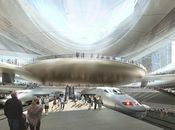
Electrified railway networks spread throughout the country with the country having one of the most extensive rail networks in the region. They are operated and maintained by the National Society of Rail Transportation (NSRT). There are also large local transport networks with most major cities having underground services or tramways. Bus services are also well present, both with local and national networks.
Air transport is common place, namely for international travel. Take Off, the largest Kernansquillecan based airline, is the main operator out of Kernansquillec's five international airports in Kernansquillec City, New Southampton, Port Mairie, Louargat and Mur-de-Kernansquillec. As the country's carbon emissions dropped off before disappearing in the late-1800s, commercial Kernansquillecan air travel initially all but died out until fusion powered aircraft were developed in the 1970s.
Commercial space travel has also developed in recent times, with fusion powered crafts departing Louargat's aerospaceport twice a week.
Currency
The Kernansquillecan Urbk (\œʁb'k\; symbol: ₭; international code: KUK) is the official currency of the Parliamentary Republic of Kernansquillec. It is subdivided into 100 Urkşimes (symbol: ş; singular: an Urksime). The Urbk has existed under various forms since 1755. At various times, the pound sterling was commodity money or bank notes backed by gold or silver, but it is currently fiat money, backed only by the economy in the areas where it is accepted. value of gold. The Bank of Kernansquillec is the central bank of the Urbk, issuing its own coins and banknotes. It is under indirect control of the government and has had an increased role in regulating financial and banking sectors of the past years.
Since 1810, the Bank of Kernansquillec has issued the following:
- coins: 1ş, 2ş, 5ş, 10ş, 20ş, 50ş, 1₭, 2₭, 5₭
- bank notes: 10₭, 20₭, 50₭, 100₭, 200₭, 500₭, 1000₭
The Urbk has earned a local international reputation of being one of the hardest currency names to spell, often confusing visitors to Kernansquillec due to its total absence of vowels and its bizarre pronunciation. Most tourists often refer to Urbks' simply as "Ks".
Science and research
Industry
Services
Agriculture
Culture
Education
Sport
Football
Music
Media
Art
Literature and philosophy
Cinema
Cuisine
Fashion, architecture and design
See also
Notes
References
External links
| ||||||||||||||||||


